|
"---there is a
steep scar at the top of the slump and the slump moves as a whole unit,
like the end of a pendulum or an earthen glacier, with the slip face
going deep into the mound."---------2007,
by William R. Iseminger, Assistant Site Manager Public Relations,
e-mail--, "Monks Mound Slump History."
"Over time,
this upper scar had begun to drop even more, eating back into the upper
part of the mound (Monks Mound)
and it was just a matter of time before it would get to the summit and
eat into the flat surface there."---------2007,
by William R. Iseminger, Assistant Site Manager Public Relations,
e-mail--, "Monks Mound Slump History."

MONKS MOUND
SLUMP REPAIR
CAHOKIA MOUNDS SITE
MADISON COUNTY, ILLINOIS
Monks Mound is an earthen mound that has been plagued by erosion for
many years. In fact, the mound was also repaired for similar reasons
anciently by the Mississippian people who built it. The term that
archaeologists and engineers use to describe the phenomenon is slumping.
Slumping occurs when the soil in the mound becomes saturated with rain
water and a portion slips downward along a fault line or slip zone. If
the situation was left to the natural elements of wind and rain, the
largest prehistoric earthen mound in the western hemisphere might
eventually become unrecognizable. In the distant future, the impressive
multi-terraced structure of today might become more rounded and
eventually begin to lose some of its height.
|
|
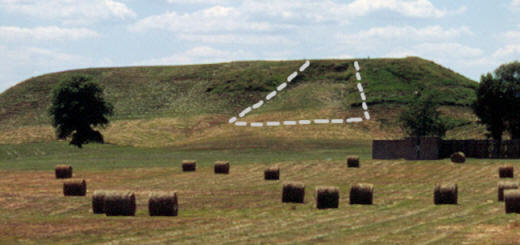
MONKS MOUND SLUMP AREA
CAHOKIA MOUNDS STATE HISTORIC
SITE
MADISON COUNTY, ILLINOIS
This picture was taken in the early nineties. The doted line shows
the area in question where it was first repaired in 1987. A
bulldozer pushed bluff top loess up the slope from below but could
not reach the steepest area at the top. The area held for several
years but slumped again about two years ago. |
|
|
This area of the mound first became damaged from slumping in 1984. The
event left a massive and steep scar that began at the top and traveled
down to the lower area of the mound. The damaged area was first repaired
in 1987 when it was filled with bluff top loess that was provided by the
Illinois Department of Transportation. They pushed the soil up from the
bottom with a bulldozer as far as they could but because of the
steepness of the slope the upper portion of the mound could not be
repaired. The lower area of the mound was also provided with additional
soil that acted like a buttress to hold back further movement. |
|

CLICK ON PICTURE FOR LARGER IMAGE
MONKS MOUND SLUMP REPAIR
CAHOKIA MOUNDS STATE HISTORIC
SITE
MADISON COUNTY, ILLINOIS
This picture shows heavy equipment beginning to refill the large
stair step excavation where the large slump feature was located on
the eastern side of Monks Mound. A large track hoe can be seen on
the top of the mound. Other equipment used was a front end loader,
compacting roller and dump trucks. |
|
|
Soil engineers later agreed that the bluff top loess that was used in
the first repair was not a good repair material. The patch held for many
years. But a couple of years ago the area once again slipped away
leaving a larger scar than before. The slippage occurred when heavy
rains saturated the soil. |
|
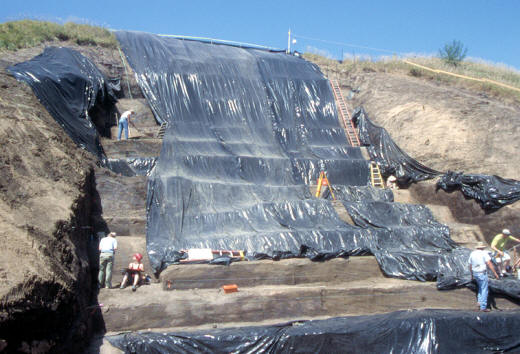
CLICK ON PICTURE FOR LARGER IMAGE
MONKS MOUND SLUMP REPAIR
CAHOKIA MOUNDS STATE HISTORIC
SITE
MADISON COUNTY, ILLINOIS
This picture shows the area that was excavated by a track hoe down
to and below the main slip zone. The stair step structure is
believed to be the best way to stabilize the slump damage. The area
was later back filled with a different type of soil than was taken
out. This picture also shows archaeologists mapping the soil
features in the side and step walls. The soil features showed
ancient erosion repair and the mound construction process. |
|
|
This most recent repair project was again conducted in order to try and
save the mound structure from further damage. It was thought that doing
nothing would eventually cause the top surface of the mound to begin to
erode away. This repair project is the most aggressive engineering plan
done to the mound to date. It involved large earth moving equipment such
as track hoes, front end loader, compacting roller and dump trucks. |
|
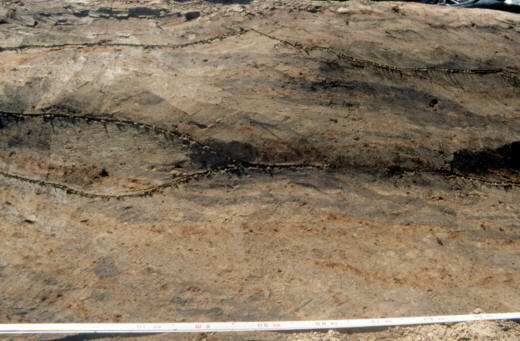
CLICK ON PICTURE FOR LARGER IMAGE
MONKS MOUND SLUMP REPAIR
SOIL FEATURE
CAHOKIA MOUNDS STATE HISTORIC
SITE
MADISON COUNTY, ILLINOIS
The only archaeological excavation during the slump repair project
was straightening and scrapping the side and step walls then mapping
the soil features. The mound was constructed with alternating basket
loads of black gumbo and sandy soil. Areas of ancient erosion repair
was also recorded. |
|
|
This September, 2007 repair to Monks Mound involved cutting large stair
steps, approximately seventy feet long, up the steep slope. The soil was
excavated behind the slip zone so that portion of the erosion feature
was no longer an issue. The area was then back filled with a more stable
soil material. The stair step structure was thought to be the best plan
of action to fix the problem in a more permanent way. |
|
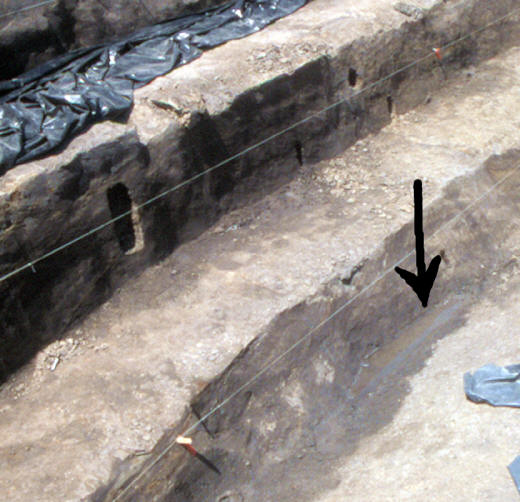
MONKS MOUND SLUMP REPAIR
CAHOKIA MOUNDS STATE HISTORIC
SITE
MADISON COUNTY, ILLINOIS
This picture shows water seeping out of the mound at the lowest step
in the excavated area. Even though the area is undergoing a drought
the large mound still exhibits an active movement of water within
the mound. |
|
|
The only archaeological feature found within the eastern slump
area, besides the earthen structure itself, is a cypress post and some
limestone slabs that were found near the top of the mound. These
materials had become partially moved out of their original location from
the two slumping events. No other information has been provided about
these artifacts. The steps and side walls of the excavation were scraped
straight and smooth so the original mound construction and ancient
repair features could be recorded. Some of these features indicate
erosion damage that was anciently repaired. The mound construction
technique was done with alternating basket loads of black gumbo and
sandy soil. |
|
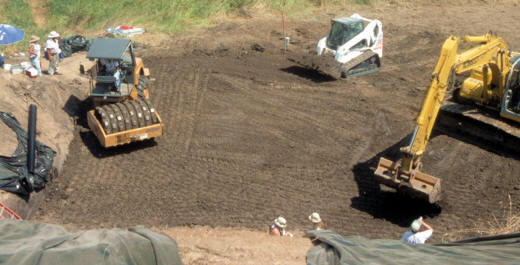
MONKS MOUND SLUMP REPAIR
CAHOKIA MOUNDS STATE HISTORIC
SITE
MADISON COUNTY, ILLINOIS
This picture shows the final refilling process of the slump repair
project. The soil is dumped by one operator, spread out by another
and compacted by yet another. |
|
|
Monks Mound was constructed approximately one thousand years ago. It has
survived because people in the area have always wanted to preserve it.
The Ramey family, who once owned the farm, protected the mound until the
state of Illinois purchased the property. The only enemy Monks Mound has
now is mother nature. Ancient engineers built and repaired it and
today's engineers will continue the same process. |
|
"REFERENCES"
2007,
Isminger, William R., e-mail--, "Monks Mound Slump History."
2007, Personal communications with Larry Kinsella.
|
|
RECENT
LISTINGS HOME
ORDERING |